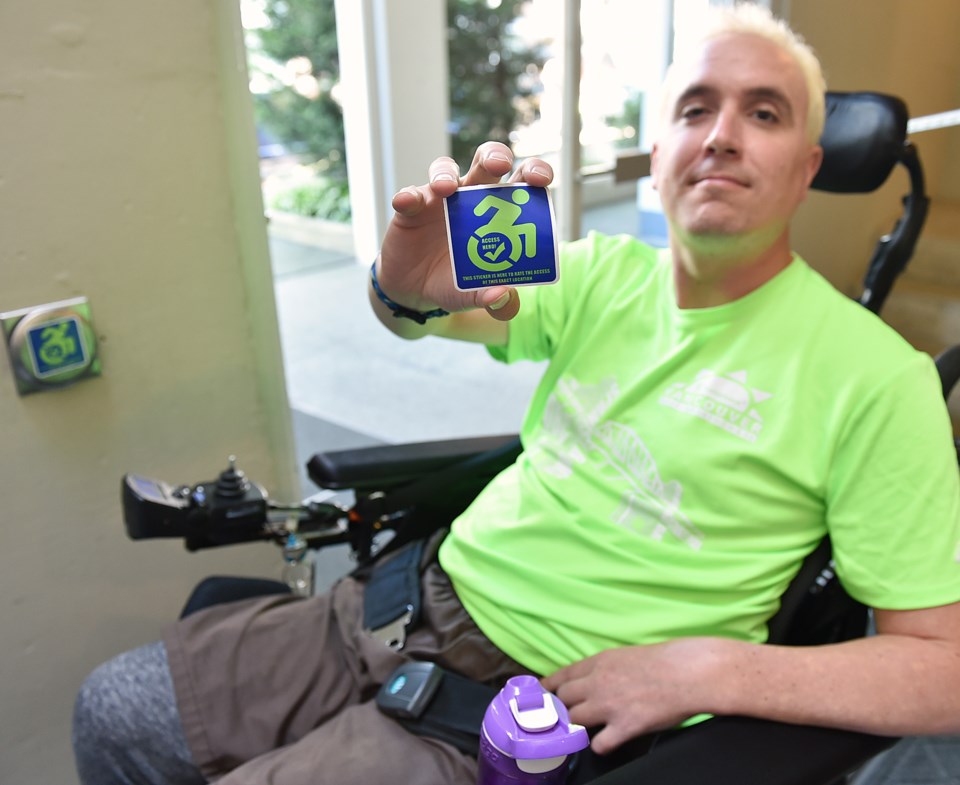Mark Stockbrocks is sticking it to the man.
The 37-year-old Kitsilano resident recently launched his one-man advocacy effort known as Access Stickers, which is meant to assess the level of accessibility at clubs, rinks, restaurants and other buildings across the city.
Stockbrocks’ messaging comes by way of stickers: buildings deemed accessible are given a green sticker with the words “Access Hero” written on it. Those on the other side of the fence get a red sticker and are deemed an “Access Zero.”
Access Stickers started less than a year ago and was the result of Stockbrocks’ increasing frustration around trying to plan a night out with friends.
“I always call these places ahead of time to see if they’re accessible because I’ve been let down so many times,” he said. “And even if I’m told a place is wheelchair accessible, I’ll show up and it’s not.”
Stockbrocks had a stroke when he was 31 and is triplegic: both his legs are paralyzed, along with his left arm. Once he visits a place and it gets the requisite sticker treatment, Stockbrocks takes pictures of the building and posts them on his social media channels.
Since September 2016, Stockbrocks has visited hundreds of locales in Vancouver and across North America. The end goal is to provide info to others with mobility challenges so they know what they might encounter across the city. He also liaises with business owners to tell them what the mobility challenges are at a given site, and tries to link those decision-makers with others in the accessible building trades.
His direct approach is, at times, not met with the warmest of receptions.
“Although I border on a somewhat militant, direct-action approach, I always have a polite, yet very assertive demeanour,” he said. “I maintain a level of respect while at the same time applying mild pressure for people to do the right thing.”
To get around any nastiness, Stockbrocks emphasizes two things: the social benefit of making buildings more accessible and the potential for a business to make more money.
Stockbrocks said it’s often the latter point that gets the ball rolling.
“Usually it comes down to talking about money and telling a manager that these investments pay for themselves in no time,” he said. “With more traffic coming through the door, you’re making more money and your investments pay for themselves. That’s what they listen to and I approach this kind of conversation from that angle.”
There’s no specific checklist or manual that Stockbrocks adheres to when making the hero or zero call, though he does look for some necessities: a wheelchair ramp, automatic doors for opening and closing and the way curbs are situated outside of a business. After his initial assessment, Stockbrocks does follow-up work to help business owners on their path to hero status.
“We have a pretty older demographic as a population in general. That shift keeps coming and it’s going to hit us hard when we have lots of people in crutches, canes and wheelchairs,” he said. “I know what I’m doing is the right thing to do and I believe in it.”
Stockbrocks’ efforts can be seen online on Instagram (@accessstickers) or on Facebook at facebook.com/accessstickers.
@JohnKurucz
jkurucz@vancourier.com



